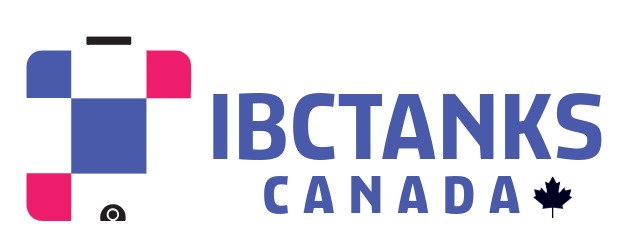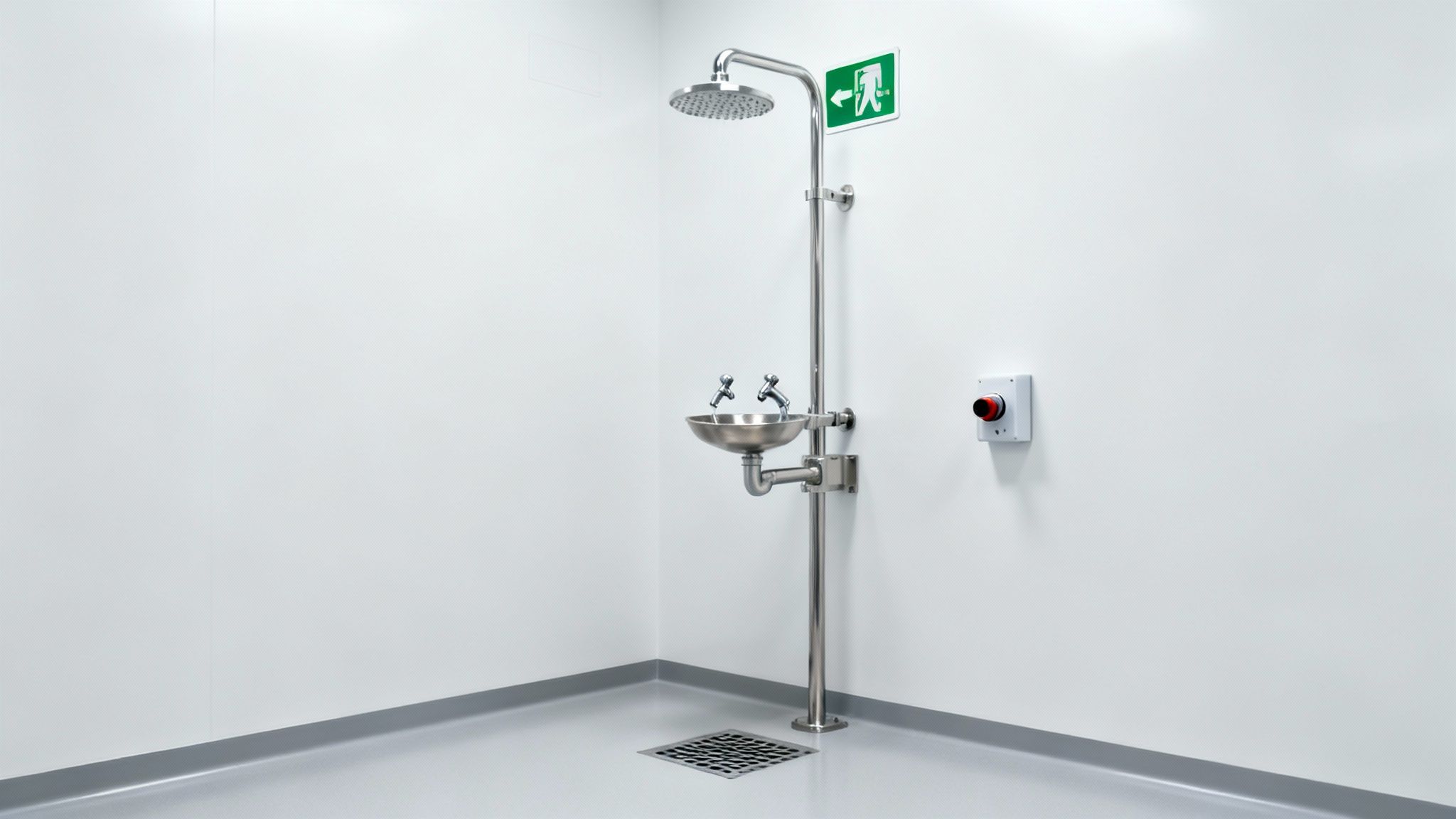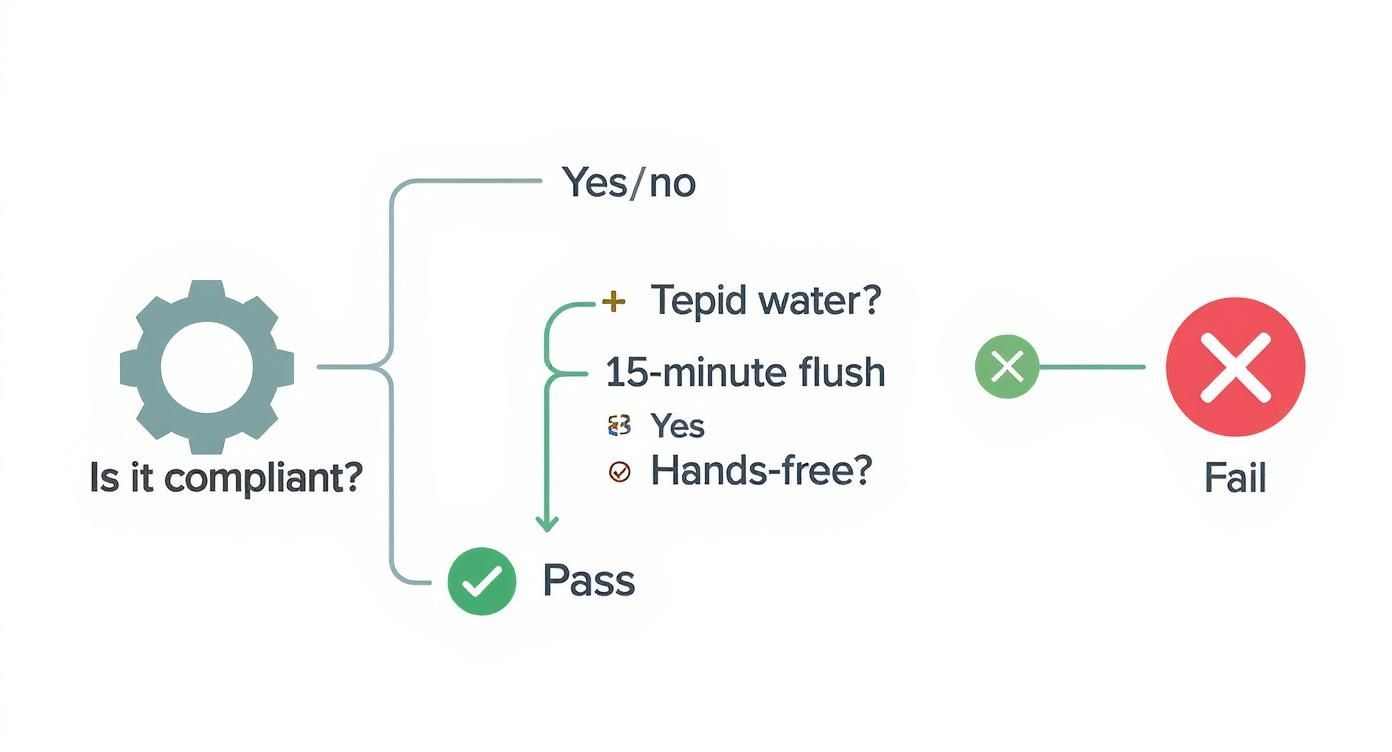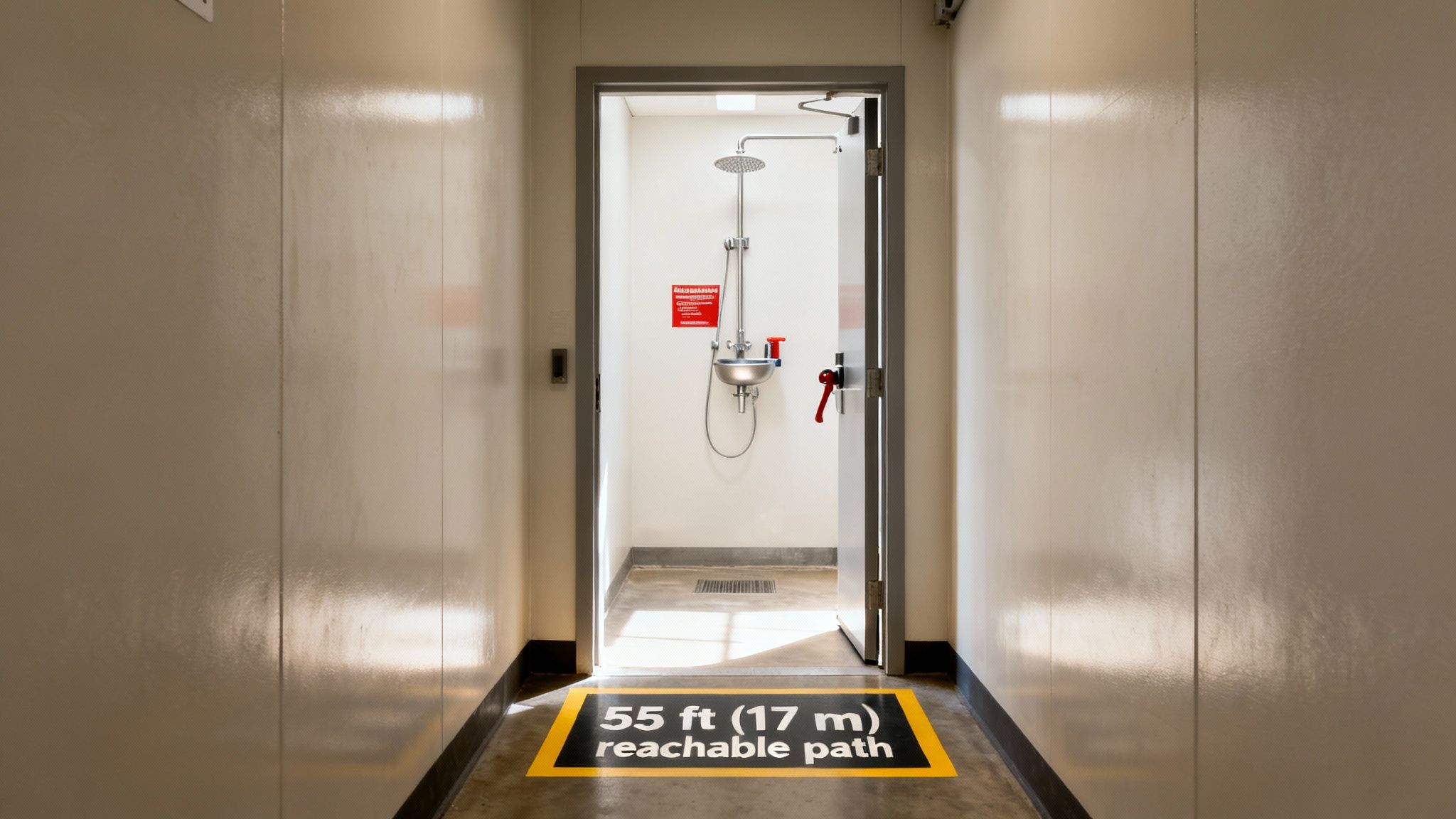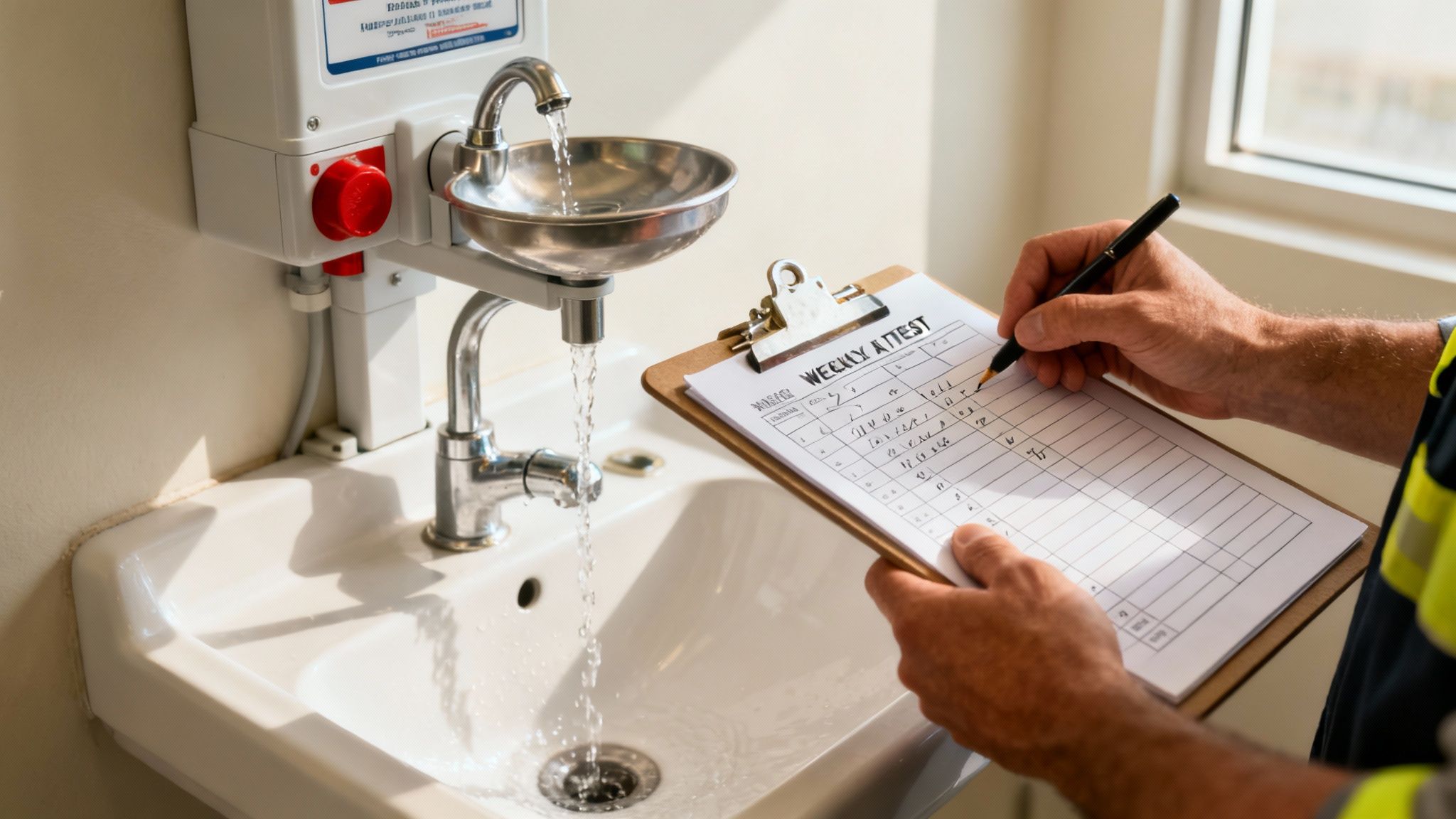Your cart is currently empty!
Tag: ANSI Z358.1
-

Emergency Shower and Eyewash Stations Workplace Guide
When you're dealing with hazardous materials, an emergency shower and eyewash station isn't just a piece of equipment—it's your first, and most critical, line of defence. Think of it like a fire extinguisher for a chemical splash. Its immediate use can be the single most important factor in preventing a severe, life-altering injury.
Your First Defense Against Chemical Exposure
In the moments right after a chemical splash, every single second is crucial. The whole point of an emergency shower and eyewash station is to provide on-the-spot decontamination, flushing harmful substances away from the skin and eyes to stop an injury in its tracks. This isn't just a "nice to have"; it's a foundational part of any workplace where chemicals are handled.
Waiting even a few extra seconds to start flushing can dramatically worsen the outcome. A fast response can mean the difference between a minor irritation and permanent tissue damage or even blindness. That's why these stations are built for simplicity—easy to find and quick to activate, delivering a high volume of flushing fluid right when it's needed most.

Understanding the Stakes
The immediate goals of using an emergency shower or eyewash are simple but absolutely vital:
- Dilute Contaminants: The water instantly starts to lower the chemical's concentration on the skin or in the eyes.
- Wash Away Substances: A continuous flow physically pushes dangerous liquids and particles off the body.
- Begin Neutralization: Flushing is the first step in returning the affected area to a normal pH.
This guide is designed to cut through the jargon for facility managers, safety officers, and anyone working near these hazards. We’ll walk through the key safety standards, help you choose the right gear for your facility's specific risks, and cover the essential installation and maintenance routines you need to follow.
In California, for instance, Cal/OSHA standards are very specific. They require eyewash stations to deliver at least 0.4 gallons per minute for 15 minutes, while emergency showers must provide a minimum flow of 20 gallons per minute for that same 15-minute period to be effective. You can learn more about California's specific safety requirements for emergency wash stations to see just how detailed these rules are.
By the end of this guide, you'll have a clear, practical roadmap to make sure your facility is not just compliant, but genuinely prepared. We'll help you turn that piece of equipment in the corner into a cornerstone of your safety program.
Decoding Key Safety Standards and Regulations
Navigating the safety rules for an emergency shower and eyewash station might seem complicated, but it all comes down to a single, critical goal: protecting your people. The main document you need to know is the ANSI/ISEA Z358.1 standard. Think of it less as a rigid rulebook and more as a practical guide to make sure your equipment actually works when it matters most.
This standard isn't just a suggestion. Regulatory bodies like OSHA lean on ANSI Z358.1, effectively making its guidelines the law of the land. Staying compliant is about more than just avoiding penalties—it's about proving your commitment to a safe workplace.
The "Why" Behind the Rules
The requirements laid out in the standard aren't arbitrary; they’re built on the real-world needs of someone who has just been exposed to a hazardous chemical. Every rule is there to prevent a failure that could turn a bad situation into a catastrophic one. Once you understand the logic, following the rules becomes second nature.
For example, the standard has evolved over decades based on what we've learned from past incidents. As chemical use became more common in industries, the need for clear emergency protocols grew right alongside it. At one point, chemical exposure incidents in the Western U.S., including California, were responsible for roughly 15,110 worker injuries each year, with a large chunk of those being eye injuries. You can dig deeper into how California's safety standards have evolved to address these very real risks.
Core ANSI Requirements Explained
Three foundational rules from the ANSI Z358.1 standard are designed to give an injured person the best possible chance of a full recovery.
-
The 15-Minute Flush: The equipment must provide a continuous, steady flow of flushing fluid for at least 15 minutes. This isn't a random number; it's the minimum time needed to properly rinse away most contaminants and dilute what's left to less harmful levels.
-
Tepid Water Supply: The water temperature must be "tepid," which the standard defines as being between 16-38°C (60-100°F). If the water is too cold, it can cause hypothermia and shock, making it impossible for someone to stay in the shower for the full 15 minutes. If it's too hot, it could actually speed up a chemical reaction or cause thermal burns, making the injury worse.
-
Hands-Free Operation: The activation valve needs to be incredibly simple—it must go from off to on in one single motion and stay on by itself. This is crucial because it leaves the injured person's hands free to hold their eyelids open, ensuring a thorough and effective flush where it's needed most.
These three pillars—duration, temperature, and ease of use—work in concert. They create a system that's not just effective, but genuinely usable for someone who is likely in pain, panicking, and disoriented.
Of course, the first step is always identifying your workplace hazards. If you're storing chemicals in bulk, knowing the meaning of a https://ibctanks.ca/flammable-liquids-placard/ is a key piece of your overall safety puzzle. In the same way, following proper emergency exit signage requirements helps guide everyone to safety in an emergency. When all these safety standards work together, you create a workplace that is truly prepared and resilient.
Choosing the Right Emergency Equipment for Your Needs

Not all hazardous materials pose the same threat, and not every workplace has the same layout. That’s why picking your emergency shower and eyewash gear isn't a one-size-fits-all job. You’ve got to take a hard look at your specific environment, the chemicals you're actually working with, and what your facility can support.
Getting this right isn’t just about ticking a compliance box; it’s about giving your team the most effective first line of defence when seconds count.
Plumbed Versus Self-Contained Units
Your first big decision is whether to go with a plumbed-in station or a self-contained unit. This choice really sets the tone for everything from installation to your ongoing maintenance plan.
A plumbed emergency shower and eyewash station hooks directly into your building’s water lines. The huge advantage here is a virtually endless supply of flushing fluid. For permanent spots where you're always handling chemicals—like labs, manufacturing floors, or dedicated storage areas—this is the gold standard.
On the flip side, self-contained units are standalone systems with their own internal supply of flushing fluid. They’re the perfect solution for a few key situations:
- Remote Locations: Think construction sites, agricultural fields, or any temporary job site where plumbing is a non-starter.
- Tricky Water Supplies: If your facility's water pressure is all over the place or you can't get the temperature right, a self-contained unit gives you a consistent, ready-to-go solution.
- Filling in the Gaps: In a large facility, you can use them to supplement your main plumbed stations and make sure no corner is left unprotected.
The trade-off, of course, is the upkeep. Plumbed units just need a quick weekly flush to keep the lines clear. With self-contained units, you have to be more diligent about checking and changing the fluid on the manufacturer's schedule to keep bacteria from growing.
This infographic gives you a great visual checklist for making sure your station meets the key ANSI Z358.1 standards.

As you can see, failing on any one of those points—whether it's the tepid water, the 15-minute flush time, or hands-free operation—means the station isn't compliant.
Matching the Equipment to the Hazard
Beyond the water source, you need to think about the type of protection required. A small lab working with minor irritants might get by just fine with a simple faucet-mounted eyewash. But what about a battery charging station? An exploding battery could drench a worker’s entire upper body in acid. In that scenario, nothing less than a full combination drench shower and eyewash station will do.
To help you decide, let's look at the different equipment types.
Comparison of Emergency Station Types
This table breaks down the main types of emergency wash stations to help you see which one fits your specific needs. It compares them based on their water source, best-use cases, and what you can expect in terms of maintenance.
Equipment Type Water Source Best For Maintenance Needs Eyewash Station Plumbed or Self-Contained Areas with risks of small splashes to the eyes only. Weekly activation (plumbed); fluid checks/changes (self-contained). Eye/Face Wash Plumbed or Self-Contained Hazards that could splash the entire face, not just the eyes. Weekly activation (plumbed); fluid checks/changes (self-contained). Drench Shower Plumbed Full-body exposure to hazardous chemicals. Weekly activation to clear lines and test functionality. Combination Unit Plumbed Any area with both eye/face and body exposure risks; most versatile. Weekly activation of both the shower and eyewash components. Ultimately, the goal is to choose equipment that provides complete coverage for the credible risks your team faces.
The core principle is simple: the level of protection must match the level of risk. Overlooking this can leave your team dangerously exposed, even if you have equipment installed. Your goal is to eliminate any gaps in your safety net by carefully aligning the equipment with the real-world hazards your employees face every day.
Getting Installation Right: It's All About Rapid Access
Even the best emergency shower and eyewash station is worthless if someone can't get to it in time. Installation isn't just a matter of hooking up pipes; it’s the step that turns a piece of equipment into a life-saving tool. At the end of the day, it's about making sure someone who is in pain, disoriented, or even temporarily blinded can get help, immediately.

This idea is so critical that it's the foundation of the most important rule in the ANSI Z358.1 standard: the 10-second rule.
Understanding the 10-Second Rule
The standard is crystal clear: any worker should be able to get from the point of a chemical splash to the emergency station in 10 seconds or less. This isn't just a friendly suggestion—it has major, real-world implications for where you place your equipment.
Put yourself in the shoes of someone who just got splashed with a corrosive chemical. Ten seconds is the absolute maximum time they have to find help, and they might not be able to see. This translates to a distance of about 17 metres (55 feet).
Just as important, the route to the station must be a straight shot, on the same level as the hazard.
- No Obstructions: The path needs to be completely free of clutter, machinery, or stored materials. Anything that could cause a trip or slow someone down is a violation.
- No Stairs or Ramps: A person in distress can't be expected to navigate changes in elevation.
- No Doors (with a few exceptions): If a door is absolutely necessary, it can't be locked and must swing open in the direction of travel to the station.
Getting this wrong is one of the most common—and serious—safety mistakes a facility can make. In fact, improper placement is a leading reason for citations. For a deeper look at common safety issues, you can review details on the most frequently cited Cal/OSHA standards. It really drives home how seriously regulators treat the accessibility of this equipment.
The Nuts and Bolts of Activation
Beyond location, the technical details of the station are just as vital. The activation valve has to be panic-proof. This means a single, simple push or pull is all it should take to get the water flowing.
Crucially, the valve must be a "stay-open" design. Once it’s on, it stays on. The user shouldn't have to hold a handle or lever to keep the water running. This hands-free operation is essential, freeing up the injured person to hold their eyelids open for a full, proper flush. And of course, keeping the area clearly marked is part of the package; our guide on signage for areas with authorized personnel only can help you ensure your facility is safe and compliant.
Water In, Water Out: Flow and Drainage
The final piece of the puzzle is managing the water itself. Your plumbing has to be up to the task, capable of delivering the required flow rates—20 gallons per minute for showers and 0.4 gallons per minute for eyewashes—at a consistent pressure.
Thinking about drainage is just as important as the water supply. A drench shower can dump hundreds of gallons of water in 15 minutes. If you don't have a plan for where that water goes, you've just swapped a chemical hazard for a massive slip-and-fall hazard.
Make sure you install floor drains or containment systems to handle the runoff. This keeps the area around the emergency station safe for the injured person, first responders, and anyone else in the vicinity.
Your Essential Maintenance and Testing Checklist
An emergency shower or eyewash station is one of those things you install hoping you'll never have to use it. But if that day comes, it has to work perfectly—no excuses. Think of it like a fire extinguisher; you can't pull the pin in an emergency only to find out it's empty. That's why consistent, documented maintenance isn't just a good idea; it's the only way to ensure this critical equipment is ready to go.
This isn’t just a friendly suggestion. It's a core requirement of the ANSI Z358.1 standard. Skipping these checks can lead to total equipment failure, turning a minor incident into a life-changing injury. A solid maintenance schedule is your proof of due diligence and a vital part of keeping your team safe.

The Weekly Activation Flush
The most common and crucial task is a quick weekly activation. This simple flush keeps the water flowing and helps head off two major problems that could knock your station out of commission when you need it most.
First, it clears out sediment and bacteria. Water that just sits in pipes becomes stagnant, which is a perfect environment for rust, gunk, and microbial growth. A weekly flush pushes all that buildup out, making sure the water is clean in an emergency.
Second, it verifies the station actually works. This is your chance to see with your own eyes that the valve opens correctly and there are no blockages. It’s a fast, simple check that confirms the unit is operational. This doesn't need to be a long test—just run it long enough to clear the line and see a steady flow.
The Comprehensive Annual Inspection
Once a year, it's time for a much deeper dive. Your emergency showers and eyewash stations need a full-blown inspection to make sure they still meet every single requirement of the ANSI standard. This is a head-to-toe performance review where nothing gets overlooked.
This annual inspection is the official moment of truth. It confirms that the equipment will perform exactly as it's supposed to during a real emergency, going way beyond the simple weekly flush to test every critical function.
Your annual checklist should include verifying:
- Correct Flow Rate: Is the shower pushing out at least 20 gallons per minute (GPM) and the eyewash delivering a minimum of 0.4 GPM? Knowing how to test water pressure at home can be a handy skill for making sure your plumbed units have enough supply to meet these numbers.
- Tepid Water Temperature: The water has to stay within the 16–38°C (60–100°F) range.
- Proper Spray Pattern: The eyewash needs to create a gentle, aerated stream capable of flushing both eyes at once.
- Valve Operation: Does the valve go from off to on in one second or less and stay open on its own?
- Clear Accessibility: Is the path to the station still completely unobstructed, meeting that crucial 10-second rule?
To keep things straight, here is a simple breakdown of the ANSI Z358.1 testing schedule.
Emergency Equipment Testing Schedule
Frequency Required Actions Purpose Weekly Activate plumbed units long enough to clear the supply line. Visually inspect self-contained units for fluid levels. Ensures functionality, clears sediment, and reduces microbial contamination in the lines. Annually Conduct a full performance test to confirm compliance with all ANSI Z358.1 requirements (flow, temperature, etc.). Verifies the equipment meets all operational standards for an emergency response. Following this schedule is non-negotiable for maintaining compliance and, more importantly, ensuring worker safety.
Documentation and Special Considerations
Every single test, from the quick weekly flush to the detailed annual inspection, needs to be documented. An inspection tag attached right to the unit with the date and the inspector’s initials is the standard way to do it. This log becomes your official record for safety auditors and regulatory inspectors.
For self-contained units, the stakes are even higher. You must check the flushing fluid levels regularly and replace the fluid based on the manufacturer's expiry date to prevent contamination. And if you're dealing with chemicals stored in large containers, pairing your emergency station with a solid spill containment pallet is a smart move to manage hazards from every possible angle.
Common Questions About Emergency Showers and Eyewash
Even with clear standards on the books, a lot of questions pop up when you're dealing with emergency showers and eyewashes in the real world. Getting these details right is key for everyone, from the facility manager to the folks on the floor, so let's clear up some of the most common points of confusion.
Does the Water for an Emergency Shower Need to Be Warm?
Yes, it absolutely does. The official term in the ANSI Z358.1 standard is "tepid," which means the water needs to be somewhere between 16°C and 38°C (60°F and 100°F). This isn't about making it a comfortable experience; it’s a vital safety measure.
Think about it: if the water is freezing cold, it could send someone into shock or cause hypothermia. No one can stand under a frigid spray for the required 15 minutes. On the flip side, water that's too hot can actually speed up a chemical reaction or even cause thermal burns, making a bad situation much worse. The solution is a thermostatic mixing valve, which blends hot and cold water to keep the temperature safely in that tepid zone.
How Often Do I Need to Test My Eyewash Station?
There’s a two-part rhythm to testing. First, plumbed eyewash and shower units need a quick activation every single week. This weekly flush is crucial—it clears out any rust, scale, or sediment that might have built up in the pipes and confirms that you have flow.
Then, once a year, it's time for a full-blown inspection. This is a deep dive to make sure everything meets the ANSI standard, from the flow rate and spray pattern to the water temperature. Keeping a log or hanging a tag on each unit to document these tests is non-negotiable; it's your proof of compliance when an inspector comes calling.
Simply put, weekly tests confirm it works; annual tests confirm it works correctly. Both are essential to be sure the equipment is ready when seconds count.
Can an Emergency Shower Be Behind a Door?
This is a tricky one. A door is a major obstacle, but it's permissible under very strict conditions. The number one rule is that an injured person must be able to get from the hazard to the station in 10 seconds or less, and the path must be totally unobstructed.
If you absolutely must have a door, it can never, ever be locked. It also has to open in the direction of travel towards the shower. This way, a person who can’t see clearly can just push through it instead of having to stop, fumble for a handle, and pull.
What Training Do Employees Need for Eyewash Stations?
Training is where the rubber meets the road. Every single employee working near potential chemical hazards has to know the exact location of the nearest emergency shower and eyewash station without having to think about it.
They need to be shown how to turn the unit on, understand why the full 15-minute flush is so important, and know what to do if a coworker needs help. This isn't a one-and-done thing, either. Initial training is a must for new hires, but everyone needs a refresher at least annually to keep the procedures fresh in their minds.
At IBC Tanks Canada, we know that a safe liquid handling operation starts with the right equipment. Whether you need UN-rated totes for hazardous chemicals or the right accessories to keep your systems in top shape, we have the reliable solutions to ensure your facility is prepared and compliant. You can explore our complete range of IBCs and parts at https://ibctanks.ca.
